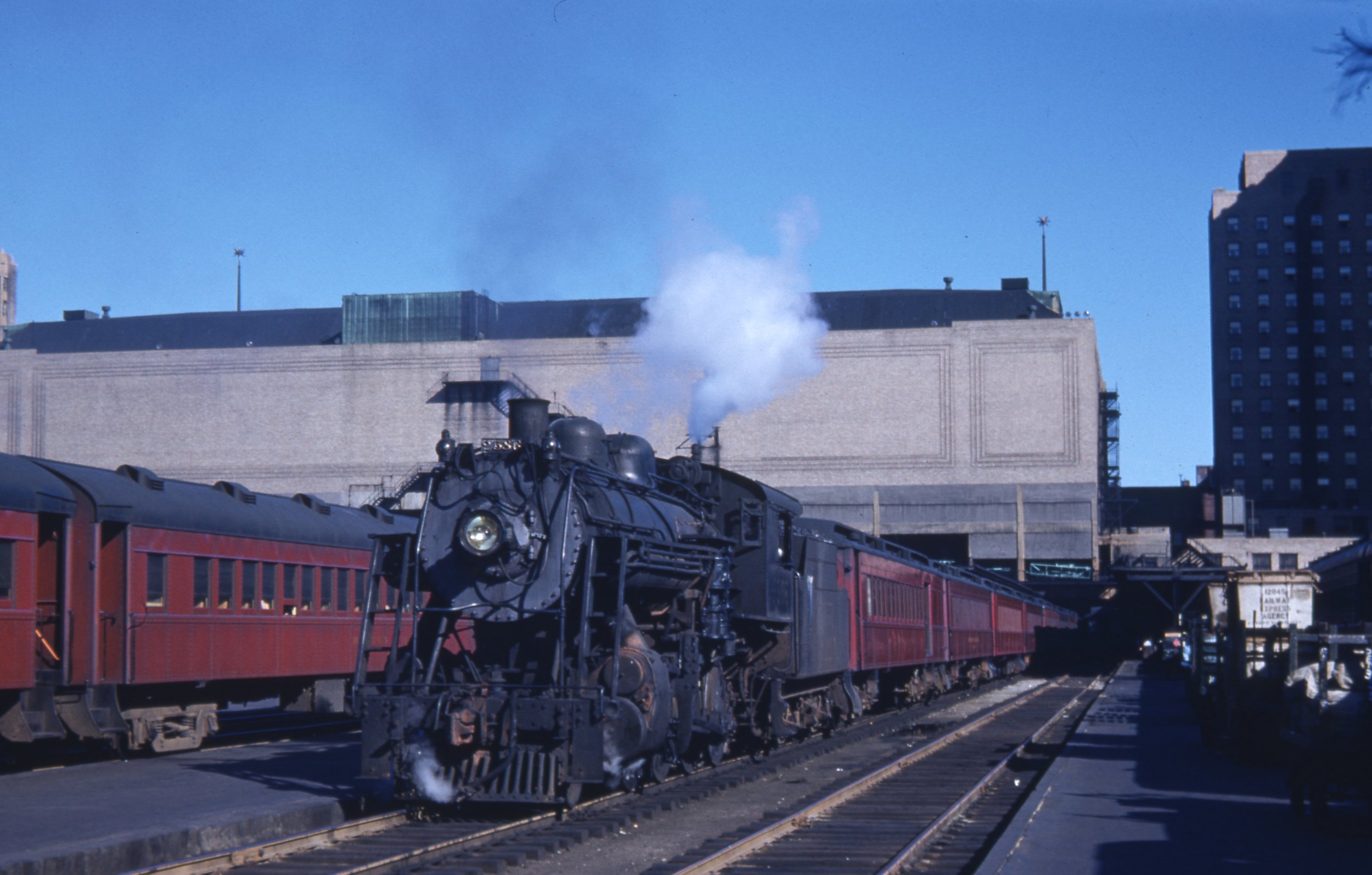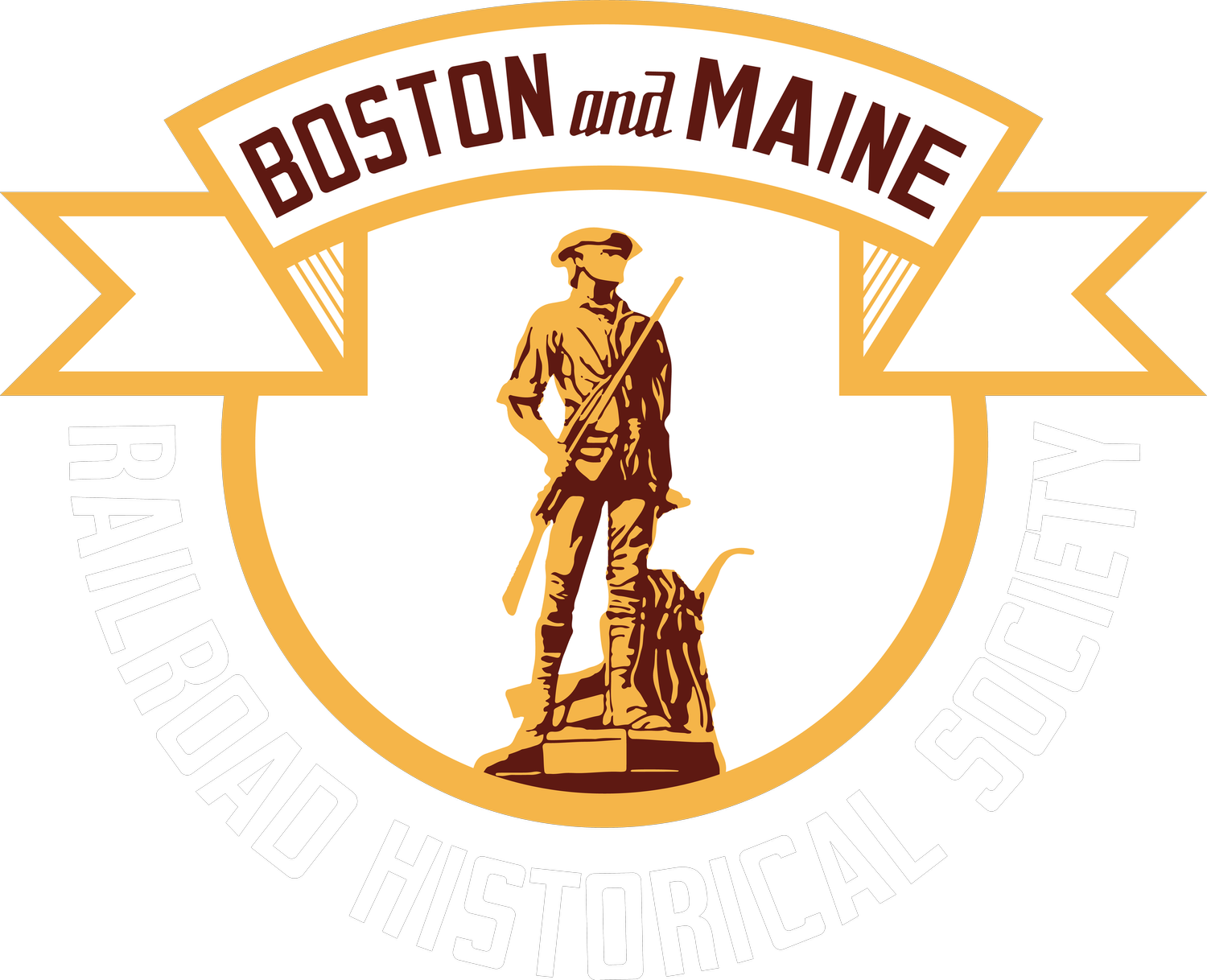
A Brief History of the Boston and Maine Railroad
The invention of the steam railroad in the 19th Century radically expanded human mobility and commerce. By “annihilating distance” the railroad forever changed the American landscape and patterns of business and domestic life. Originating in the idea of constructing a continuous inland route between Boston and Portland, the Boston and Maine Railroad gradually gained control of other lines until the B&M system linked hundreds of cities, towns, and villages in Massachusetts, Maine, New Hampshire, Vermont, and New York.
Shipments of grain, ice, lumber, meat and produce over its rails contributed to the expansion of Boston as a market center and a great seaport. The B&M and its predecessor companies made possible the development of New England’s manufacturing cities and eliminated the crushing isolation of life in the country. For most communities it became the link to the outside world. It also found markets for the products of each town’s industry and in return brought to every locality the whole range and variety of goods that were the fruit of the Industrial Revolution.
The Boston and Maine Railroad was the successor to the Andover and Wilmington Railroad which opened in 1836. Over the next 65 years the B&M gained control (through lease, purchase, or stock ownership) of the Eastern, Boston and Lowell, Connecticut and Passumpsic Rivers, Concord & Montreal, Connecticut River, Fitchburg, Portland and Rochester, and Worcester and Nashua railroads, most of which themselves were agglomerations of shorter, earlier roads. All had their main lines and branches that wove a tight web of steel through northern Massachusetts, southern Maine, the state of New Hampshire, and eastern New York and Vermont. At its peak B&M maintained over 2,300 route miles of track, 1,200 steam locomotives, and a force of 28,000 employees. The road’s principal shops were located at North Billerica, Mass. and Concord, N.H. Major freight yards were built at Boston, East Deerfield, Rigby, and Mechanicville.
Developing Tourism
The B&M led the charge for the development of tourism in New England. The delights of Lake Winnipesaukee and the White Mountains, the promotion of seacoast resorts, and the romantic attractions of New England’s historic places were captured in B&M view-books, magazines, and extensive newspaper advertising. In the 1930s and 1940s the Boston and Maine Snow Trains were a major boost to the development of the winter sports business.
The B&M’s most famous engineering landmark was the five-mile-long Hoosac Tunnel. Hundreds of the railroad’s bridges enhanced the New England landscape, ranging from picturesque covered bridges to the Greenville and Hillsboro trestles, the Clinton viaduct, and huge steel structures spanning the Merrimack and Connecticut rivers. Notable, also, was the gradual filling in of the flats of Boston, Cambridge, and Somerville, and their development as New England’s principal freight distribution center.
The B&M came under the control of J.P. Morgan and the New York, New Haven and Hartford Railroad about 1910, but shortly thereafter anti-trust forces wrested effective control away from New Haven.
The B&M's consolidation with the Eastern RR included assumption of the Eastern's funded debt. This, combined with the debt incurred in the 1870s for construction of a new route to Portland and fixed lease obligations to acquire the Fitchburg and other railroads, led the B&M into a festering financial crisis that was settled by a reorganization of the road in 1919. Several leased lines voluntarily merged with the B&M to avoid a meltdown of the B&M system.
About 1890 street railways made the first assault on the B&M’s passenger business. Increased use of the automobile, from about 1915, made more trouble for the B&M as a passenger carrier, beginning the erosion of its local and commuter business. In the 20th Century freight business was adversely affected by the decline of New England manufacturing and by short-haul truck competition. Nevertheless, the B&M made valiant attempts to preserve its freight and passenger traffic by abandoning unprofitable branches, improving freight handling facilities, upgrading passenger equipment, and making forays into the airline, motor cargo, and bus businesses.
Advancing through Technology
Never technologically backward, the B&M was an early proponent of switch and signal interlocking, automatic block signaling, automatic train stop, and centralized traffic control. Under president George Hannauer hump yards were established at Boston and Mechanicville and the Freight Cut-Off was established to funnel freight cars away from busy passenger routes. It employed gasoline powered rail motor cars on lightly patronized branches and was one of America’s diesel pioneers; its iconic Unit 6000, the Flying Yankee streamliner (1935), symbolized a hopeful new age in railroad innovation.
In 1955 financial operator Patrick B. McGinnis gained control of the Boston and Maine. His principal contribution to B&M history was to oversee the completion of dieselization, the discontinuance of many passenger routes and runs, and the closure and sale of railroad stations and equipment. Ultimately he was convicted of and imprisoned for taking kickbacks on equipment sales.
In the late 1950s and 1960s profitability was elusive; Government insisted that the B&M should keep commuter and long-distance passenger trains running in the face of mounting deficits and decreasing patronage and made it impossible for the B&M to break even. Demonstration projects to improve passenger earnings by running more frequent trains were inconclusive, and the drain on assets continued. Expenses were reduced by dieselization and the closure of stations and shops, but the B&M ultimately fell victim to the ever-growing use of motor transportation and the advent of the Interstate Highway System. The railroad gave up on long distance passenger service after 1960 and was able to continue Boston commuter service only by securing subsidies from the Massachusetts Bay Transportation Authority (MBTA).
Reinventing Itself — Freight Service
Bankruptcy came in 1970, but ironically it seems to have been the catalyst that the B&M needed to reinvent itself. Alan Dustin (president 1974-84) reduced operating expenses and plowed the savings back into track improvements. The sale of rights of way in the commuter zone to the MBTA (1976) provided cash to satisfy creditors and in 1980 the B&M had its first profitable year, on an ordinary income basis, since 1957. An improving outlook led to the purchase of the B&M by Timothy Mellon’s Guilford Transportation Industries in 1983 and its emergence from bankruptcy. In addition to its freight service the B&M continued to operate Boston commuter trains under contract to the MBTA.
Guilford had purchased the Maine Central Railroad in 1981 and then, with B&M in the fold, began to operate the two roads as a continuous system. Guilford changed the complexion of freight operations by concentrating on large shippers and experimenting with dedicated, high volume, services. Guilford expanded its operations into Connecticut by the acquisition, in 1982, of several track segments from Conrail. Combining these segments with trackage rights, Guilford extended its reach from Springfield as far south as New Haven and as far west as Waterbury and Derby.
A labor dispute prompted Guilford to lease B&M track (1986-1987) to subsidiary Springfield Terminal Railway, which thus became Guilford’s operating company for freight business. B&M lost the contract for running MBTA commuter service to Amtrak in 1987; Massachusetts Bay Commuter Railroad ran commuter service over former B&M lines from 2003 to 2014; Keolis Commuter Services took over on July 1, 2014. Short line freight railroads such as Providence and Worcester, New Hampshire Northcoast, and New England Central purchased segments of former B&M right of way and continue to serve online customers.
Guilford acquired Pan American World Airways in 1998, and re-branded itself as Pan Am Railways. In 1999, in cooperation with Norfolk Southern, Pan Am began running a dedicated intermodal train between Ayer and Mechanicville. This evolved into an agreement with Norfolk Southern in 2008 to own, as a joint venture named Pan Am Southern, former B&M track between those two points, and elsewhere, using NS money to upgrade the track and to finance improved distribution facilities. Containerized freight, raw materials for paper mills, forest products, and automobile shipments constituted a large part of Pan Am business.
On June 1, 2022, CSX acquired Pan Am Railways for a purchase price of $600 million.
Passenger Service Today
The MBTA’s operation of former B&M commuter service has been a 40-year balancing act of subsidies, fare increases, capital improvements, budget constraints and political maneuvering that comes with public ownership of railroads. A period of line shortenings and service reductions was followed by some extensions of service. Venerable Budd rail diesel cars were replaced with push-pull equipment. Modern station facilities were constructed, some with floor level platforms. Signal upgrades, restoration of double track, and installation of welded rail, have immensely improved the right of way since the seventies. Today the T (under agreement with Keolis) operates the Haverhill, Newburyport/Rockport, Lowell, and Fitchburg Lines over former B&M rails.
Long-distance passenger trains to Maine returned in 2001 with the inauguration of Amtrak’s Downeaster Service. Currently, the Downeasters makes five round trips daily between Boston and Brunswick.
Along the B&M’s former Connecticut River Division, the Valley Flyer operates between Springfield and Greenfield, Mass. and Amtrak’s Vermonter Service between Springfield and White River Junction.
Rick Nowell, Archives Chairman
Boston and Maine Railroad Historical Society
January 23, 2024
